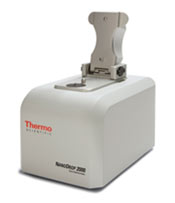Protein concentration: Difference between revisions
Jump to navigation
Jump to search
Measuring protein concentration using NanoDrop
Procedure (used at Rutger's University)
Procedure (University of Toronto)
mNo edit summary |
mNo edit summary |
||
| Line 1: | Line 1: | ||
== Measuring protein concentration using NanoDrop<br> == | == Measuring protein concentration using NanoDrop<br> == | ||
Both Rutger's University and University of Toronto use the UV absorbance at 280 nmr to determine protein concentrations. | |||
Absorbance by proteins is due to the aromatic rings of Phe, Tyr, and Trp residues. | |||
Extinction coefficients are estimated using the Expasy ProtParam tool (a description of the equations used for this calculations can be found [http://ca.expasy.org/tools/protparam-doc.html| here] ) | |||
=== === | |||
=== Procedure (used at Rutger's University)<br> === | === Procedure (used at Rutger's University)<br> === | ||
| Line 21: | Line 30: | ||
#Wipe the sensors and pipette on 2 μL of your protein sample. Bring down the lever arm. | #Wipe the sensors and pipette on 2 μL of your protein sample. Bring down the lever arm. | ||
#Click Measure and record the concentration measured. | #Click Measure and record the concentration measured. | ||
#In order to determine protein concentration, make note of the intensity at 280 nm. | #In order to determine protein concentration, make note of the intensity at 280 nm. | ||
#To test multiple samples, just wipe the sensor in between measurements with a Kimwipe. Recalibration or re-blanking is not necessary. | #To test multiple samples, just wipe the sensor in between measurements with a Kimwipe. Recalibration or re-blanking is not necessary. | ||
#Clean the sample surfaces once more after you are finished. | #Clean the sample surfaces once more after you are finished. | ||
<br> [[Image:Nanodrop.jpg]] | <br> [[Image:Nanodrop.jpg]] | ||
=== Procedure (University of Toronto)<br> === | === Procedure (University of Toronto)<br> === | ||
Revision as of 20:02, 21 December 2009
Measuring protein concentration using NanoDrop
Both Rutger's University and University of Toronto use the UV absorbance at 280 nmr to determine protein concentrations.
Absorbance by proteins is due to the aromatic rings of Phe, Tyr, and Trp residues.
Extinction coefficients are estimated using the Expasy ProtParam tool (a description of the equations used for this calculations can be found here )
Procedure (used at Rutger's University)
concentration = Absorbance at 280 nm divided by absorbance coefficient
Typical protein concentration measurement protocol with NanoDrop-2000 with connected PC computer.
- Before starting the software module, clean the sample surfaces with DI water to remove any dried sample that might be present.
- Alternatively, you can clean the sample surfaces with a Kimwipe moistened with 70% ethanol.
- Open the Nanodrop program and the appropriate module (e.g., Protein).
- Wipe off the top and bottom sensors of the instrument with a Kimwipe. These are just the polished ends of fiber optic cable, so wiping is sufficient to prevent carryover.
- Pipette 2 μL of DD water onto the sensor. Bring down the lever arm.
- Follow the onscreen prompts to calibrate.
- Wipe the sensors and pipette on 2 μL of the corresponding blank (Buffer solution your protein is in). Bring down the lever arm.
- Follow the onscreen prompts to blank.
- Wipe the sensors and pipette on 2 μL of your protein sample. Bring down the lever arm.
- Click Measure and record the concentration measured.
- In order to determine protein concentration, make note of the intensity at 280 nm.
- To test multiple samples, just wipe the sensor in between measurements with a Kimwipe. Recalibration or re-blanking is not necessary.
- Clean the sample surfaces once more after you are finished.
Procedure (University of Toronto)
Since july of 2009, we use thermofisher nanodrop1000 to measure the protein absorbance at 280 nm.
The molecular weight and theoretical extinction coefficient are calculated using expasy.
